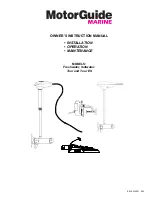
RN2483 LoRa™ Technology PICtail™/PICtail Plus Daughter Board User’s Guide
DS50002366A-page 16
Advance Information
2015 Microchip Technology Inc.
Another case is that the motherboard does
not
have power supply. In this case, the
motherboard can be powered from the USB together with the daughter board. User
must take care of the maximum output current of the on-board LDO, which is 500 mA.
A short on the jumper JP_RST on the daughter board forces the board to operate in
PICtail mode, although USB remains connected. The jumper JP_RST keeps the
on-board PIC18 MCU in reset state to ensure that USB-to-UART protocol translation is
not
performed in this mode. If jumper JP_RST is
not
shorted, on-board PIC18 MCU has
the priority over the UART communication.
2.3
COMMUNICATION TO THE MODULE
In PICtail mode, the Microchip 8/16/32-bit PIC MCUs on the motherboards can run
custom functions and connect to the module using the UART interface, which accepts
ASCII commands from the host.
In USB mode, when the daughter board is connected to the host via USB, the on-board
PIC18 MCU uses the CDC class to create a USB-to-UART bridge device. The host can
run a simple terminal emulator application to issue commands.
2.4
HARDWARE DESCRIPTION
The RF signal path is connected to the SMA edge connectors. The 433 MHz band RF
signal is transmitted through RFL SMA edge connector, whereas RFH SMA connector
is used for the 868 MHz band.
The current consumption measurement of the module is supported by the on-board
current measure jumpers. If jumper CUR1 is shunted, the supply current flows directly
to the module.
There are two ways to measure current consumption:
• A current meter can be connected to CUR1 jumper pins to measure the actual
current consumption of the module. CUR2 must be left open.
• The current consumption graph can be recorded in the time domain by removing
the shunt from CUR1 jumper and shunting CUR2 at the same time. Use a two
channel oscilloscope, which supports subtracting mathematical function. Connect
oscilloscope probes to CUR1 jumper pins while CUR2 jumper is shunted. Set the
oscilloscope to display the difference between the two channels.
All pins of the module can be accessed via through hole pads which is located on both
sides of the module. User can mount two 1.27 mm pitched socket headers if required.
Sockets can connect the module pins to a custom board, whereas the daughter board
provides the power. The through hole pads are classified into two groups which are
located on both sides of the module. Each pad group, J1 and J2, has a dedicated pad
on which power is delivered to the custom board. The supply current is measured
together with the module's supply current. To do this, JP2 must be shorted for J2 and
JP3 for J1.
If the supply current is separated from the module, the other two jumpers must be
shorted. To power the custom board separately, shunt JP1 or JP4.
The on-board PIC18 MCU is programmable via programming port ICSP_IC2. In USB
mode, LD1 and LD2 LEDs indicate communication on the UART.
Note:
Only 30-pin PICtail Plus connection is detected. If the daughter board is
attached to a 28-pin PICtail connector, the jumper JP_RST has no affect.











































